I believe this is more of a MongoDB question than a Meteor question, so don't get scared if you know a lot about mongo but nothing about meteor.
Running Meteor in development mode, but connecting it to an external Mongo instance instead of using Meteor's bundled one, results in the same problem. This leads me to believe this is a Mongo problem, not a Meteor problem.
The actual problem
I have a meteor project which continuosly gets data added to the database, and displays them live in the application. It works perfectly in development mode, but has strange behaviour when built and deployed to production. It works as follows:
- A tiny script running separately collects broadcast UDP packages and shoves them into a mongo collection
- The Meteor application then publishes a subset of this collection so the client can use it
- The client subscribes and live-updates its view
The problem here is that the subscription appears to only get data about every 10 seconds, while these UDP packages arrive and gets shoved into the database several times per second. This makes the application behave weird
It is most noticeable on the collection of UDP messages, but not limited to it. It happens with every collection which is subscribed to, even those not populated by the external script
Querying the database directly, either through the mongo shell or through the application, shows that the documents are indeed added and updated as they are supposed to. The publication just fails to notice and appears to default to querying on a 10 second interval
Meteor uses oplog tailing on the MongoDB to find out when documents are added/updated/removed and update the publications based on this
Anyone with a bit more Mongo experience than me who might have a clue about what the problem is?
For reference, this is the dead simple publication function
/**
* Publishes a custom part of the collection. See {@link https://docs.meteor.com/api/collections.html#Mongo-Collection-find} for args
*
* @returns {Mongo.Cursor} A cursor to the collection
*
* @private
*/
function custom(selector = {}, options = {}) {
return udps.find(selector, options);
}
and the code subscribing to it:
Tracker.autorun(() => {
// Params for the subscription
const selector = {
"receivedOn.port": port
};
const options = {
limit,
sort: {"receivedOn.date": -1},
fields: {
"receivedOn.port": 1,
"receivedOn.date": 1
}
};
// Make the subscription
const subscription = Meteor.subscribe("udps", selector, options);
// Get the messages
const messages = udps.find(selector, options).fetch();
doStuffWith(messages); // Not actual code. Just for demonstration
});
Versions:
Development:
- node 8.9.3
- mongo 3.2.15
Production:
- node 8.6.0
- mongo 3.4.10

